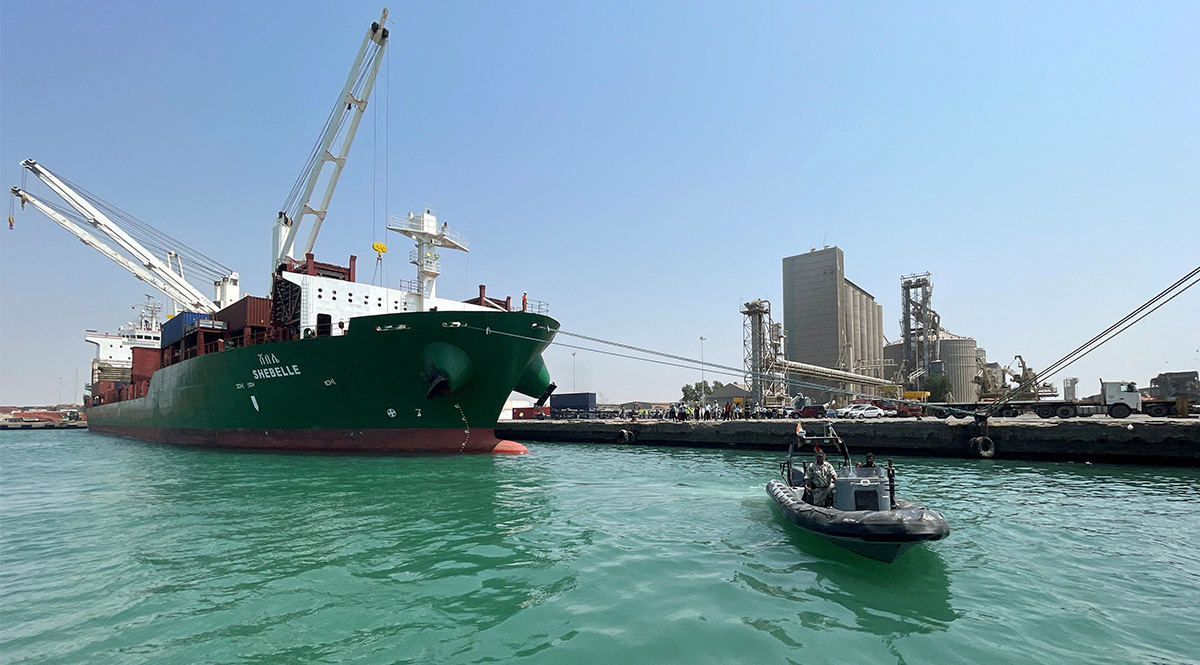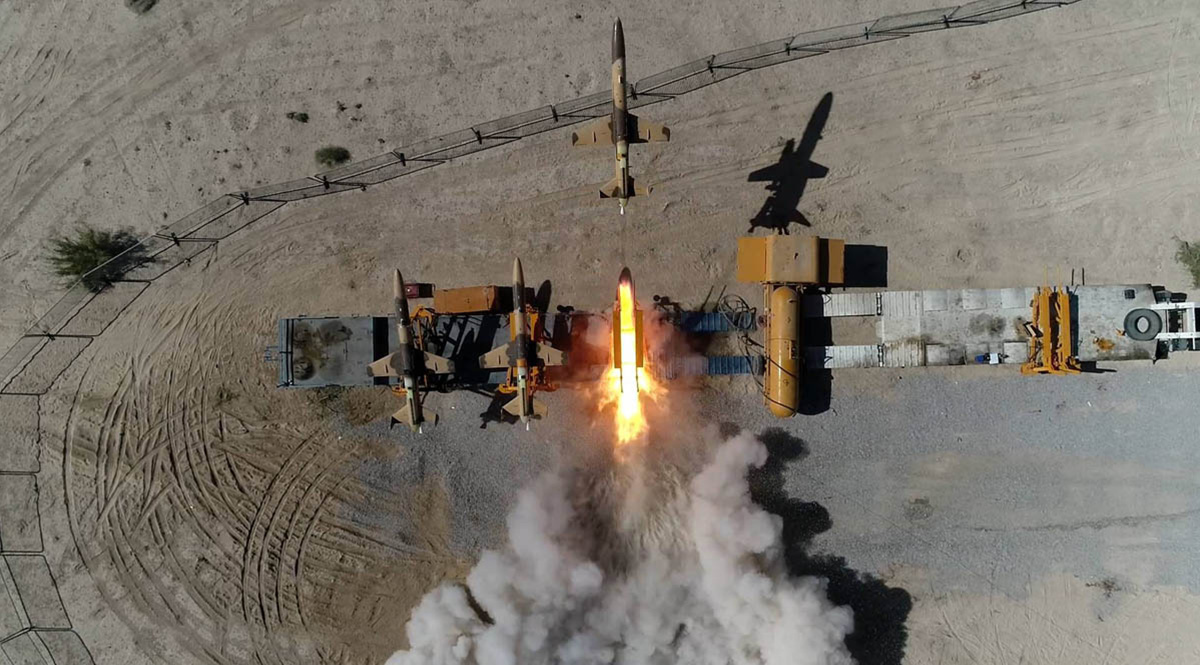Attacks in the Red Sea Have Broader Economic Consequences
Attacks by pro-Iran Houthi militias operating in Yemen on ships transiting the Red Sea, conducted since November last year, have seriously disrupted international trade. This has increased sea transport costs and shortages of production components, including in the European Union. In addition to enhancing the safety of navigation in this area, it is important in the long-term, among others, that the EU diversify its trading partners, especially given strategic products.
 KHALED ABDULLAH / Reuters / Forum
KHALED ABDULLAH / Reuters / Forum
In the conflict between Israel and Hamas that broke out in October 2023, Houthi fighters supported the Palestinian side. Thanks to their control over a large part of Yemen’s coast, they launched large-scale attacks on merchant ships sailing through the Red Sea, mainly around the Bab al-Mandab Strait. Officially, the strikes were aimed at ships heading to ports in Israel, but other vessels were also affected. By mid-February, more than 30 ships had been attacked. In response, a coalition of the U.S., the UK, and several other countries has been taking military action since January to protect communication routes and hit the military potential of the Houthis. The European Union is also preparing an operation aimed at increasing shipping safety in the region. India has also sent ships to the Gulf of Aden, and China’s navy is escorting Chinese merchant ships.
The Importance of the Red Sea
The transit area is key for international trade. The communication routes running there are the shortest between Europe and Asia. According to UNCTAD, 12-15% of global trade in goods and about 20% of container transport passes through the Suez Canal, connecting the Red Sea with the Mediterranean Sea (in total, maritime transport accounts for 80-90% of the volume of global trade in goods). Data from the S&P Global agency show that it also accounts for about 15% of imports of European, Middle Eastern, and North African countries. Around 320 million tonnes of bulk goods (e.g., grains, metals) flow through the canal annually, which is 7% of global transport.
The Red Sea routes are important for many economic sectors in countries in Europe, Middle East, and North Africa. In this context, S&P Global mentions, for example, the automotive industry (supplies through this area are responsible for, among others, 66% of imports of lithium-ion batteries and 48% of braking systems), the chemical industry (24% of inorganic chemicals), and consumer goods (40% of clothes, 50% footwear, 47% toys, 40% household appliances). Products transported to Asian countries through the Suez Canal include 41% of imports of passenger cars and 40% of dairy products. This route is also important for energy markets, with about 12% of oil transported by sea through it. According to the Vortexa analytical company, in the period January-November 2023, 8.2 million barrels of oil and petroleum products were transported daily through the Red Sea. According to S&P Global calculations, in 2023, 8% of global LNG by volume was transported via the sea.
Trade Disruptions
Although the Suez Canal is open, the deteriorating security situation in the Red Sea has prompted numerous companies to abandon this route, including Denmark-based Maersk, Hapag-Lloyd (Germany) and Nippon Yusen (Japan). Others, such as OOCL (Hong Kong), refuse to transport goods to and from Israel. As a result, in January this year 36% fewer ships passed through the Suez Canal than in January 2023. At the beginning of February 2024, 57% fewer vessels had used it than a year earlier. Ships instead are being redirected to the route around the southern coast of Africa. This extends voyages by 3,000 nautical miles and 10 days, resulting in higher fuel usage and costs and longer delivery times. Changing routes and logistical disruptions further increase freight prices. The Freightos platform reports that at the end of January, the price of transporting a 40-foot container from East Asia to Northern Europe was $5,500, compared to $1,500 in mid-December last year. Another factor contributing to the price increase is the reduced capacity of the Panama Canal because of low water levels in the channel caused by climate change. Companies that want to continue using routes through the Red Sea must also pay higher insurance rates, which have jumped by 50% more than before the attacks. The Kiel Institute for the World Economy found that in December last year, world trade decreased by 1.3% in comparison to a month earlier (noting also a slight increase in January).
Longer delivery times result in shortages of supplies, such as production components. This affects the automotive industry and others in the EU. This has led to temporary shutdowns by, among others, Tesla at its plants in Germany, Volvo in Belgium, and Suzuki in Hungary. The pharmaceutical industry, including the Polish company Polpharma, also has been affected by the tightening of supplies and increased costs. There are also shortages of containers in ports, mainly in Asia, which makes it difficult to fulfil orders. Trade disruptions also result in higher prices for raw materials and agricultural products. For example, the prices of antimony, a metal used in the production of batteries for electric vehicles and semiconductors, have increased. A similar situation may soon apply to other strategic raw materials, such as bismuth and manganese. Wheat deliveries through the Suez Canal fell by almost 40% in the first half of January, and the price of coffee rose by about 9%. However, the disruptions have not had a significant impact on the Brent crude oil price, which has fluctuated at around $80 per barrel, which is the same as at the beginning of November last year. This may be due in part to the slowdown in the global economy, which has reduced overall demand for oil. However, it is also possible that the higher transport costs have not yet been fully incorporated into the price. Data from the IMF PortWatch platform show that at the beginning of 2024, almost a half as many tankers were passing through the Red Sea daily than a year earlier.
In response to the situation in the Red Sea, logistics operators are using intermodal transport more often. Hapag-Lloyd offers the use of a land corridor from the ports of Jebel Ali in the UAE as well as Dammam and Jubail in Saudi Arabia to Jeddah to bypass the most dangerous area of the Bab al-Mandab Strait. Maersk, in turn, is organising air transport of products delivered by ship to ports in Oman and the UAE. Road routes from Bahrain and the UAE to ports in Israel and Egypt are also used.
Conclusions and Perspectives
Attacks in the Red Sea significantly disrupt the functioning of global supply chains. The effects include increases in transport prices and disruption of production cycles. At the beginning of this year, however, the volume of world trade was quite stable, which may be the result of, among others, increased purchases ahead of a production break in East Asia for the Lunar New Year celebrations in mid-February. While the impact of the disruption is expected to be limited in the short term, a prolonged threat to shipping through the Suez Canal is likely to have significant consequences for the global economy. It may contribute to the persistence of elevated inflation in the U.S. and the EU, among others, and thus postpone decisions by central banks to reduce interest rates. The effects on the trade of European countries, China, Japan, South Korea, India, the ASEAN countries and others may soon translate into a slowdown in global economic growth. These consequences will intensify if the crisis in the Middle East widens. The longer ship routes also generates increased greenhouse gas emissions. Threats to transport through the Red Sea may also have a negative impact on global food security, exacerbating the difficulties in exporting agricultural products from Ukraine to countries in Asia and Africa. They will also be an argument for more frequent use of the Northern Route through the Arctic, especially by countries, namely China, that have good relations with Russia. In a longer term, the disruption to shipping may also increase interest in the development of the India-Middle East-Europe Economic Corridor.
From the EU’s perspective, it is worth considering maintaining a permanent military presence in the Red Sea to protect merchant ships, also in cooperation with other partners, for example as part of the ATALANTA mission, which covers the northwestern Indian Ocean. Actions aimed at ending the war in the Gaza Strip are also important, as it would weaken the Houthis’ arguments for the attacks and be conducive to stabilising the situation in the Red Sea region.
If the attacks continue, there may be further problems in the supply of components and raw materials to EU countries and an increase in their costs. This applies, for example, to the transport of LNG from Qatar, the largest user of the Suez Canal in the industry and an important supplier of liquefied natural gas to Europe (about 13% of imports), including to Poland, which has already suspended traffic on this route, as well as other materials important for the digital and energy transformations, as well as for military purposes. To increase the EU’s economic security, further diversification of the directions of its economic cooperation is needed, especially in the field of critical technologies. Cooperation between governments and enterprises (e.g., through industry associations) in analysing threats to supply chains and stockpiling supplies of components and raw materials may be important in this respect. Poland can be active in this field by, for example, joining the Minerals Security Partnership, established in 2022 on the initiative of the U.S. (it currently has 13 countries and the EU as parties). To reduce the costs of future crises in the Suez Canal, it would be useful to prepare investments in cooperation with the private sector (e.g., as part of the Global Gateway strategy) and establish emergency supply routes for key raw materials and components, including by rail and air.





